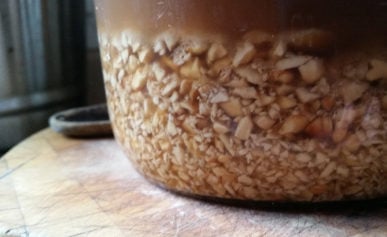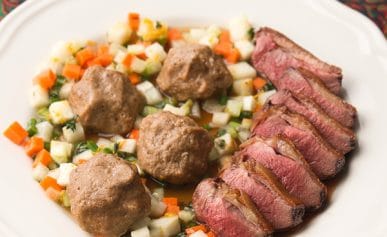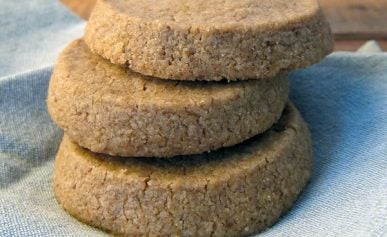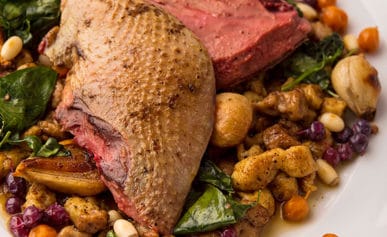As an Amazon Associate I earn from qualifying purchases.
Yes, you can eat acorns, and all acorns are edible — it’s just that most need special processing. Here’s how to go about it.

If you haven’t read my other acorn posts, Acorns and the Forager’s Dilemma is an introduction to the use of acorns; the Forager’s Dilemma is, in a word, starch. Starch (carbohydrates) is the toughest thing to gather, and is a primary reason why humans settled down 10,000 years ago to grow grain.
Next I wrote about how various world cultures have traditionally used acorns, cultures ranging from Korea to Japan to the Native Americans, Europeans and North Africans.
Let me say loud and clear that you can eat acorns and all acorns are edible, at least all species of acorns are. We’ll get into details in a bit.
Basically there are three ways to eat acorns: Eating them as nuts (they are a lot like chestnuts), making acorn flour, or cooking in acorn oil. I have not yet tried to make acorn oil, but that link leads you to my friend Sam Thayer’s website; he sells it.
Collecting Edible Acorns
First you need to get yourself a supply of acorns. Go find some oak trees; they’re the ones with all the acorns that have fallen down around them. I know this sounds condescending and stupid, but oaks come in so many varieties that in autumn this really is the easiest way. It is a bit of a crapshoot, as it is tougher to determine a variety of oak by its acorn than by its the leaf — you can do it, but it is a little harder.
You can gather acorns anytime from September until early spring. I find gathering as the acorns fall is best. Suellen Ocean, who wrote a very useful book Acorns and Eat ’em,says she likes to collect Tanoak acorns in February and March, after many have begun sprouting.
She says acorns with sprouts between 1 to 2 inches long are still good to eat, but discard any acorn meats that have turned green. Ocean says recently sprouted acorns a) have begun to turn their starch into sugar, and b) are foolproof: “If it is sprouted, it’s a good acorn and I haven’t wasted time gathering wormy ones.”
A word on worms. When I first gathered acorns, little did I know that I had gathered scores already infected with the larva of the oak weevil. Nasty little maggoty things, you can tell they are inside your acorn if there is a little hole in the shell. Look for it, discard that acorn and move on. But know that oak weevil larvae bored those holes from the inside out. Like Alien.
It’s helpful to know what kind of oak you are dealing with because acorns from different oaks have different levels of tannins in them; more on that in a bit. If you don’t know your trees, start looking for little green acorns in May. Pick a leaf and compare it to oak leaves online or in a guidebook. Gather acorns and compare them to online images and guidebooks; different oaks bear acorns with different shapes.
With that in mind, remember that not all oaks are created equal, and the fundamental fact to know if you are going to eat acorns is that you are dealing with a wild food, and as such must contend with tremendous variability, both in species and even among individuals of the same species.
Some oaks bear acorns so low in bitter tannins that they can be eaten raw. Legend says that California Indians fought over these trees, which makes some sense because one mature Valley Oak can drop 2,000 pounds of acorns in a really good year. A ton of sweet acorns may well be worth fighting over.
That said, even “sweet” acorns should be leached to remove what tannins exist in them because several studies show that unleached acorns can make you constipated and can harm your teeth. Of all the species I know of, only the imported European cork oak and the Emory oak of the Sonoran Desert come close to being “sweet.”
Tannins aren’t the only thing that makes different species of acorn different. UC Riverside Professor David Bainbridge wrote in a 1986 academic paper that depending on species, acorns can range in fat content from 1.1 percent to 31.3 percent, protein from 2.3 percent to 8.6 percent, and carbohydrates from 32.7 percent to 89.7 percent. That is a huge range!
What does it mean? It means that in the kitchen you treat acorns from different species very, very differently. A fatty acorn will make a meal, like ground almonds. A carb-rich acorn — like Valley Oak acorns — makes a drier flour, more like chestnut or chickpea flour (acorns lack gluten and so will not rise.)

Differences in Various Oaks
Here’s a general breakdown:
‘Sweetest’ Acorns, meaning lowest in tannin: East Coast white oak, the Emory oak of the Southwest, the pin oak of the South, the valley and blue oaks of California, the burr oak of the Midwest, as well as the cork oak and the well-named bellota oak of Europe. To my California readers, know that there are an awful lot of cork oaks and burr oaks planted in towns and cities here, so keep your eyes peeled.
Largest Acorns: Valley oaks are really big, as are East Coast White oaks. Burr oaks are large, too, as is the California Black oak.
Fattiest Acorns: The Eastern red oak acorns I’ve used have a very high oil content, and I’ve read that the Algonquin used red oak acorns for oil. In the West, the champions are both live oaks, the Coastal and the interior live oak, as well as the tanoak and black oak, which is Quercus kellogii.
Shelling Acorns
I found that shelling the acorns is the most onerous part of dealing with them. They have an elastic shell that resists normal nut crackers. I found whacking them with a hammer to be the best way to open up an acorn. Some people use a knife, and I do this with green acorns, but not fully ripe ones.
Best way to whack ’em is to put the flat end (the side that used to have the cap) on a firm surface and rap the pointy end with a hammer, or, with long, tapered acorns like cork oak or Valley oaks, just whack the side.
Acorns are far easier to shell after they’ve dried. If you choose to dry them, do this in wide, shallow pans so they don’t get moldy. Once dried, I’ve worked with two-year-old acorns and they were fine. They will need an overnight soak before grinding, however.
Red oak acorns have a “test,” a skin that doesn’t want to come off, just like a chestnut. Easiest way to deal with this is to freeze your fresh acorns for a week or two before cracking. This will slip the skin off the nut. The skin is bitter, but it’s not that big a deal if you are making flour.
Shell your acorns into water. The meats oxidize, and you will get a lighter-colored flour if you do this. It’s aesthetic, but it matters to me.
Tannins
All acorns should be leached with water to remove bitter tannins, which will a) make your mouth feel and taste like felt, b) make you a bit nauseous, and possibly c) constipate you for days.
Getting those tannins out is the big barrier to cooking with acorns. But it ain’t no biggie. With my valley oak acorns, after shelling I drop the acorn meats directly into my stockpot that was two-thirds full of water. When I fill the pot about a third of the way up with shelled acorns, if I am in a hurry, I bring the pot of water to a boil. The water turns dark. As soon as it boils, pour the water off into the sink and repeat the process.
It requires about five changes of water to get valley oak acorns to taste like chestnuts. I did this all while watching football, and did not miss a snap. Other oaks will require more or fewer changes of water. Choose the “sweetest” acorns on my list above for the least amount of work.
There is a better method, but it takes days. Grind the raw acorns into flour, then mix a ratio of 1 cup of acorn meal to 3 cups water, or more water if you have large containers. Pour this all into a glass jar with a lid and put it in the fridge. Every day you shake the jar, wait 12 hours or more, then pour off the water — and the tannins.
How long? Anywhere from a week to two weeks, depending on how bitter your acorns are. This is a good way to leach acorns without using fuel for boiling water, and you do not denature a particular starch in the acorns that acts a little like the gluten in flour, i.e., it helps the flour stick to itself. I go into the full process of cold leaching acorns here.
If you plan on baking with the acorn flour, use the cold-water leaching method.

Once your acorns are free of tannins, you need to figure out what to do with them. Regardless, you need to dry them first or they will rot. Acorn grits can be patted dry on a tea towel. If it is hot out, lay the acorns out on cookie sheets and dry in the shade. You could also put them in an oven set on “warm.” You can also put the acorns in a dehydrator set on low heat, which is what I do.
You can also freeze your fresh acorn meal. Store dried flour in jars in the fridge. Why the fridge? What fat there is in acorns will go rancid pretty quick if you left the flour at room temperature.
What you can now do to eat acorns is pretty limitless.
My first success was an acorn flour flatbread in the style of an Italian piadina. I also make an acorn flour honey cake, which is really very tasty — almost like gingerbread cake. The flour also makes an excellent pasta dough when mixed with regular flour.
Other Ways To Eat Acorns

Acorn Grits
Acorn grits, which are useful additions to acorn soup, acorn muffins or to eat as a breakfast cereal.
Read More
Wood Duck and Acorn Dumplings
Acorn dumplings, served with wood duck — wood ducks eat acorns, so it seemed fitting.
Read More
Acorn Maple Shortbread Cookies
Acorn cookies, more or less like shortbread. A bit tricky to make, but even if they fall, they are still delicious.
Read More
Acorn Spätzle
Acorn spätzle, little German dumplings that work very well with gluten free acorn flour.
Read MoreI will also substitute about 1/5 of the flour in my homemade flour tortillas with acorn flour, and I also make mean acorn gnocchi.
Use your imagination!









I have processed acorns several times using boiling and cold water methods. I have dried them and used them fresh after leaching and I always have the same problem of them being hard to chew. Even in a baked good. Any thoughts?
Cleverhand. I rarely do pieces any more, and when I do I use them in long-simmered stews. They are indeed hard to chew unless cooked a long time.
I live in Paso Robles (Pass of the Oaks) and we have a lot of Valley Oaks (Robles). Although the shell looks normal, if I can shake the nut inside or if I dry them first to aid in cracking the nut, the nut is always black. What causes them to turn black? It will certainly darken the acorn meal but will it change the taste and is it a problem to eat those acorns after leaching them.
Terry: Honestly I am not sure, but I think it’s a mold. I toss them when they turn black. I don’t think it is harmful, however, as I have read about the Indians using them when they are black.
Pete, Sure they’ll ferment but I’d recommend using amylase to breakdown the starch. You’re not really going to be able to malt them.
Hi Hank,
I’ve been looking everywhere for some acorn processing tips. I’m glad to have run across your article. What I am hoping to do is make a beer with them – homebrewing is my passion. Free “grain” is hard to pass up. Having the nuts begin their starch to sugar conversion during the germination phase would be important.
1) How to start that process?
2) How does drying them at this point work?
Thanks for sharing your experiences!
Pete: Boy that’s a hard one. But I can tell you that they will ferment. If you make the flour as I tell you to in this post, but leave it at room temp, it will start to ferment. Beyond that, yer on yer own. But if you do it, let me know what you learn!
Hi Hank;
Thanx for your article and site. Have my first bag of acorns in the kitchen. Its cold and raining in NE this weekend so we will see how it goes. I cured black olives from the nephew’s house near Bakersfield, CA last year; so this year its acorns in New England.
eric
Thanks for the how to’s on the precious acorn for food.
There is probably more enzymes and nutrition in sprouting an acorn slightly before eating them. How would one sprout an acorn for food? I could experiment but you may already know.
I have written a few articles about oaks and acorns and their almost symbiotic link with people since Palaeolithic times. You might find them interesting.
In this post I tried to answer the question why were oak trees and oak groves considered sacred in the past? Maybe the reason is that oaks are one of the most useful trees in the world.
https://oldeuropeanculture.blogspot.ie/2014/10/oaks.html
In this post I presented archaeological evidence we have for human consumption of acorns during the Palaeolithic, Mesolithic, Neolithic, Copper age, Bronze age and Iron age.
https://oldeuropeanculture.blogspot.ie/2014/11/acorns-in-archaeology.html
In this post I discussed the possibility that it was people who brought oaks back into Europe after the last ice age.
https://oldeuropeanculture.blogspot.ie/2014/11/how-did-oaks-repopulate-europe.html
In this post I tried to answer the question whether the acorn was the original corn and whether this is why are Thunder deities which are linked with oaks are also linked with agricultural grain cults?
https://oldeuropeanculture.blogspot.ie/2014/12/eating-acorns.html
I this post I talk about the origin of Christmas trees (pine and oak). I discussed the possibility that these trees were considered the trees of life because they were the main sources of food during the Mesolithic. I ask whether these two trees are somehow connected to the ancient idea of the garden of Eden, the Golden age “when humans enjoyed the spontaneous bounty of the earth without labour in a state of social egalitarianism”?
https://oldeuropeanculture.blogspot.ie/2014/12/christmas-trees-from-garden-of-eden.html
Finally I wrote about the possibility that the it was the consumption of acorns that lead to the invention of grinding stone. And the possibility that the Bulaun stones from Ireland are ancient acorn grinding stones, like the ones we find in North America.
https://oldeuropeanculture.blogspot.ie/2014/12/bullaun-stones.html
I just made a quart bag of acorn meal/flower from Chestnut Oaks! Pretty excited. It will end up first being made into speatzle. I boiled out the tannins…5 or 6 times…dried in oven and ground in a coffee grinder. My thumbs are killing me.
Fabulous article. Thank you.
A couple questions. You say that it is easier to work acorns when dried. I have a couple pounds of Quercus chrysolepis that I harvested yesterday. They are, indeed, difficult to process fresh. Can you offer a time frame for drying? I understand that environmental factors would affect that — but if you could talk about about what a “dried” nut would look or feel like — that will be a help.
I am also wondering if you can recall your source for the yield of 2,000 pounds from a Valley Oak Quercus lobster?
Thanks.
William: Just a few weeks should do it. They should rattle in the shell. And I can’t recall the source offhand, but it was in a book about California Indians and their foodways.
I have several oak trees in my yard and the acorns have been falling like crazy. I am going to attempt making a few things with them. I live on an Indian reservation and my husband is a native. I was taught by elders how to properly leach them etc and am going to attempt making Acorn soup, bread etc. my question is with the acorn soup do you think canning it would be pretty basic? Or is there a special step in keeping the acorn from going bad??
Rebecca: You cannot can acorn soup. And why would you want to? The flour, once made, is very stable. It’s best in a cool place, but it’s fine at room temperature. When you want soup, just add broth or whatever else you want and you’re good to go. It comes together quickly. Virtually all my acorns go into flour, and then dishes from there.
I eat them raw and it doesn’t cause me any problems, and they taste good. Maybe a difference in body chemistry?
Chris: Has to be. Unless you are eating the acorns from a very special oak tree.
I just wanted to share a new shelling trick I learned by accident. I was camping this weekend and found some nice plump acorns. I wanted to taste one to check tannin levels, but didn’t have anything to shell them with. I ended up squashing it with a nice heavy rock (this was on top of another, flatter rock), and it split perfectly in half. I’ve never opened an acorn so easily!
I ended up gathering a pint or so and taking them home. I tried the rock trick again. It works best if you do it on a concrete slab, but maybe a flat paver brick would work in a pinch. These are northern new mexico acorns, still pretty soft, but as acorn gathering season is upon us I will test it out with some other varieties.
I have located a lovely Burr Oak at a fort near Sacramento. I found the acorns last fall but the ranger cleaned up the last drop before I got to them so I had to wait for this year’s crop to drop and am walking over at lunch each day to collect whatever the squirrels haven’t bitten – these are beautiful acorns! I’m hoping I can roast them, since I’ve tried the flour and wasn’t really excited about it… lot of work, but with foraging sites being more prevalent I’m hoping I can find some great ways to use the acorns I collect. It’s FREE FOOD! :0 thank you for the information!
I’ve heard of people leaving the acorns in a flowing stream for days to leach out the tannins. I am wondering if you could do this in the ocean or if this is crazy talk?
We just had a wind come through that dropped large green acorns from my tree-I think it is a black oak by what I am finding in books. I went crazy and picked up 22 lbs in about 45 min and they are still falling. . .WHAT TO DO WITH GREEN ACORNS. Somewhere I read that they are not eatable. The brown ones are very small and 2 were mushy when I open them. They are drying in the oven right now to see what happens. Ideas???
Barbara: Let them dry naturally, without an oven.
I just collected the acorns that fell off the acorn tree in my yard for fun this year, and I didn’t know about the grubs, so when I found a grub crawling around in the jar of acorns, I was a bit surprised. I finally found that if you dump them in water before you shell them and pick out the floating ones, it’s a safe bet those are the grubby ones. I don’t know if this would interfere with any of the ways to cook them or not, but I figured it was useful.
A technique I’m currently trying to gain an edge in the race for the nut with all the little crawly dudes. The step in the process after gathering is straight to the freezer for a couple of days. Just like the process for the elimination of pantry moth larvae in your oatmeal. Then to the dehydrator as soon as it’s available. My dehydrator can’t come close to keeping up with my gathering.
Blue Oak acorn flour make a great burrito, just substitute acorn for frijoles.
I’ve also experimented with acorns a fair bit and continue to. To deal with the worms: I put my acorns in a dirt sifting box that just fits over my mortar mixing pan. The worms fall through the screen on the bottom of the dirt sifting box and get caught in the mortar mixing pan. I then take the worms out to my pond and feed the bluegill. Chikens love the worms too. Oily acorns can be pressed for their oil. One variety of eastern red oak has produced a delicious oil that compares exactly to pecan oil. So delicious! and good for the skin too. I haven’t yet gotten the variety identified but I remember where those trees are!
There’s heaps of pinoaks where I live, and my parents have a cork oak planted on the naturestrip outside their house. I’ve always wanted to cook with acorns, since I read “My Side of the Mountain”. It’s Autumn now so I’ll be keeping an eye out for them. The pinoaks are street trees, would the acorns be safe or do they soak up pollution while they’re growing?
Meg: They should be OK, but focus on the cork oaks. They’re bigger and sweeter.